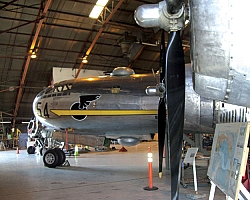Standing in a restoration hangar just north of the Museum of Flight, volunteer Dale Thompson's voice wavered a bit when he started telling the story of how the museum acquired its B-29 Superfortress.
The museum's B-29, known as T-Square 54, fought in the Pacific during World War II, flying 37 bombing missions with the 875th Bomb Squadron, 498th Bomb Group.
After the aircraft had finished its military duties, Air Force officials sent it to Naval Air Weapons Station China Lake, Calif., to finish out its final days with a few other B-29s on the desert floor serving as a target for Navy pilots.
"They told the Navy boys to shoot them," Thompson said somberly. "They didn't care."
Fortunately, the Air Force changed its mind and trucked it to the Museum of Flight in 1994. The airplane currently sits in a hangar the museum rents while it undergoes a complete restoration.
Thompson and a group of committed project volunteers care very deeply about the restoration.
 "It's a piece of history that needs to be preserved," said Thompson, who worked as an engineering manager for Pacific Northwest Bell before he retired years ago. "Our mission is to bring it back to what it looked like when it was going to take off in 1945."
"It's a piece of history that needs to be preserved," said Thompson, who worked as an engineering manager for Pacific Northwest Bell before he retired years ago. "Our mission is to bring it back to what it looked like when it was going to take off in 1945."
While the airplane will never take to the sky again, the restoration team's goal is to make it look like it can.
"If it's visible, we want it to be there," he said.
That includes all the intricate details, right down to the ashtrays located at each crew member's seat in the plane. Fortunately, volunteers have the aid of several sets of drawings and many pictures taken by Boeing officials during the production of the B-29.
"They've been extremely valuable to us," Thompson said of the materials.
The team has also received a lot of help from Boeing and its staff historian.
But that's not to say the team hasn't run into its share of missing pieces. Parts for radios and obscure fittings that can't be found anywhere anymore should still be part of the restoration, Thompson said.
"The hardest part is obtaining missing pieces and having to build others from scratch," he said. "If you can't get it, you have to make it. But we have the guys that can do it."
The restoration is rolling right along. Thompson estimates that the cockpit is 90 percent completed. Volunteers have also created a manual control box that moves the gun turrets on the aircraft.
"We have the only B-29 in the world with turrets that move," Thompson said.
Volunteers routinely take former crewmembers and their families on tours of the airplane. And when Servicemembers stop into Boeing Field on a military cargo transport plane, Thompson said they are always anxious to get a closer look at the B-29.
"So many people had fathers, brothers, uncles or grandfathers that flew this airplane," he said. "They connect with it."
For now, the airplane sits in the hangar while volunteers continue to put it back together. The museum is in the process of finding a way to display it on the grounds under a cover when it is completed.








Comments for "Preserving a piece of aviation history"
Comments for this article are currently closed.